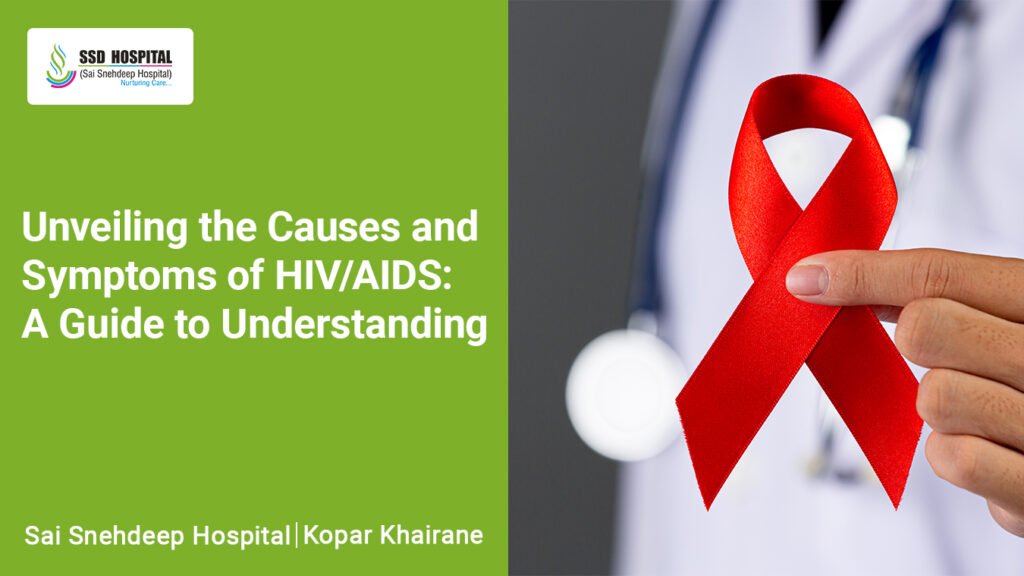Recognizing the Signs: A Guide to Understanding Stroke Symptoms Introduction:A...
Read More- hello@ssdhospital.in
- +91 8989 58 5050

HIV/AIDS is a formidable health challenge affecting millions worldwide. To combat this epidemic effectively, it’s essential to comprehend both its causes and symptoms. In this guide, we illuminate the underlying factors behind HIV/AIDS transmission and outline the telltale signs indicative of infection.
HIV, or Human Immunodeficiency Virus, is the primary culprit behind AIDS. This virus invades the body’s immune system, particularly targeting CD4 cells, weakening the body’s ability to fend off infections. The most common modes of transmission include unprotected sexual intercourse with an infected individual, sharing needles or syringes contaminated with HIV-infected blood, and mother-to-child transmission during pregnancy, childbirth, or breastfeeding. Understanding these transmission routes is vital for implementing preventive measures and minimizing the spread of HIV.
Identifying the symptoms of HIV/AIDS is crucial for early detection and timely intervention. It’s important to note that the initial stages of HIV infection may not always present noticeable symptoms, making regular testing essential, especially for individuals engaging in high-risk behaviors. However, as the disease progresses, symptoms may become more apparent. These can include:
Shortly after HIV infection, individuals may experience flu-like symptoms, including fever, fatigue, swollen lymph nodes, sore throat, and muscle aches. These symptoms typically arise within two to four weeks after exposure to the virus and may last for a few weeks.
Chronic fatigue is a common symptom of HIV/AIDS, often persisting for extended periods. This fatigue can significantly impact daily functioning and quality of life.
Significant and unexplained weight loss may occur as HIV progresses, accompanied by loss of appetite and general malaise.
HIV weakens the immune system, making individuals more susceptible to various infections. Recurrent or persistent infections, such as thrush (oral candidiasis), pneumonia, tuberculosis, and other opportunistic infections, may indicate advanced HIV disease.
Skin rashes, lesions, or sores may develop in individuals with HIV/AIDS, often due to opportunistic infections or HIV-related dermatological conditions.
HIV, or Human Immunodeficiency Virus, is a virus that attacks the body’s defense system, making it weaker over time. It targets special cells called CD4 cells. If not treated, HIV can lead to AIDS, a serious condition where the immune system is severely damaged, making it hard for the body to fight infections.
HIV spreads through certain body fluids like blood, semen, vaginal fluids, and breast milk. Common ways it spreads are through unprotected sex, sharing needles, or from a mother to her baby during childbirth or breastfeeding. It doesn’t spread through everyday contact like hugs or sharing food.
HIV is tricky because it hides in the body and doesn’t go away completely, even with treatment. While medicines can help control it, they can’t get rid of it entirely. Scientists are working hard to find a cure, but it’s a tough challenge.
Doctors test for HIV by checking the blood for the virus. If the test shows HIV is there, it’s considered positive. It’s important to find out early so treatment can start and the virus doesn’t spread to others.
HIV can spread through activities like unprotected sex, sharing needles, or from a mom to her baby during childbirth. To stay safe, it’s important to use protection during sex, use clean needles, and get tested regularly, especially if you’re at risk.
Right now, there’s no cure for HIV/AIDS, but there are medicines called antiretroviral therapy (ART) that help control the virus. They let people with HIV live longer and healthier lives. Also, there’s a medicine called PrEP that can lower the chance of getting HIV for some people. Researchers are still looking for a cure, but these treatments are a big step forward.
Understanding the causes and symptoms of HIV/AIDS is paramount for early detection, timely treatment, and prevention of further transmission. By recognizing the transmission routes and being aware of the telltale signs of infection, individuals can take proactive steps to protect themselves and others. Additionally, regular HIV testing, practicing safe sex, and accessing appropriate medical care are vital components of HIV/AIDS prevention and management.
Recognizing the Signs: A Guide to Understanding Stroke Symptoms Introduction:A...
Read MoreConquering Endometriosis: A Woman’s Guide to Symptoms, Causes, Diagnosis, and...
Read MoreEndometriosis is a common and often very painful condition that...
Read MoreHIV/AIDS is a formidable health challenge affecting millions worldwide. To...
Read MoreBook your Appointment